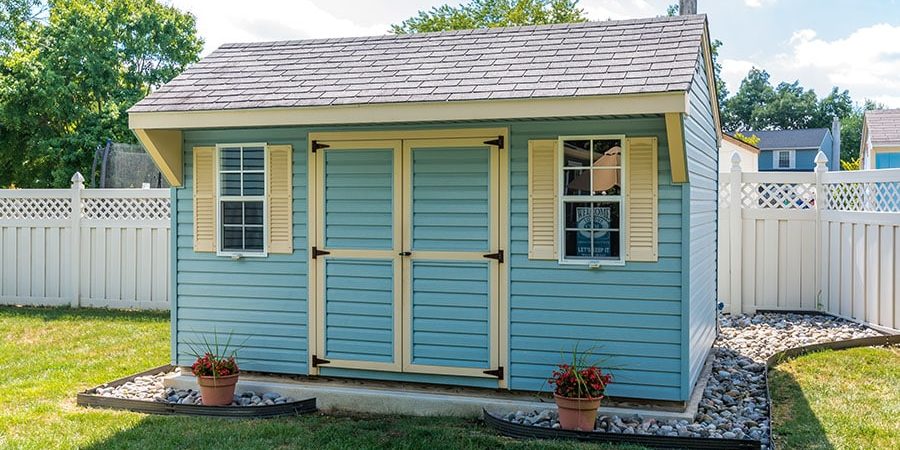Whether you’ve already bought a shed or are still weighing the options, it’s important you don’t forget the foundation.
Choosing the right base determines your portable building’s long-term success. Everything rides on a durable material that doesn’t cost too much and drains away from the shed.
Without a foundation that meets local building codes and supports the shed, you could pay thousands on unnecessary repairs.
We know that picking a shed foundation can be overwhelming with all the different shed base types. Each shed foundation option comes with different pros, cons, and price tags.
Why Do I Need a Foundation for a Shed?
It may be tempting to skip the base altogether if you’re building a smaller-sized shed.
Why not reduce costs and shorten the construction time by constructing on the ground?
It doesn’t make sense to labor over the foundation, especially if you plan to store lighter loads in the smaller shed, such as lawn equipment.
While you might be able to get away with a dirt base, the temporary storage shed and the grade underneath will take a hit. Without a shed base, you can expect:
- The shed shifting and sinking over time.
- The floor rotting due to insect and moisture exposure
- The walls deteriorating
To put it simply: a foundation, no matter the type, is better than no foundation. This is true whether you choose a timber frame, solid concrete blocks, deck blocks, cinder blocks, or even a simple skid foundation.
Know the Difference Between On-Grade and Frost-Proof Shed Foundations
Shed foundations can be divided into two categories: frost-proof and on-grade.
First, on-grade shed bases are as they sound: foundations that sit directly on the ground. On-grade shed bases are simpler to install and less expensive of the two shed base options.
Common examples include concrete foundations, gravel pads, and pavers.
Frost-proof foundations, on the other hand, go below the frost line. This depth depends on your location and where frost and freezing don’t impact the base.
One common type of frost-proof shed base is concrete piers, which are installed by pouring concrete below the frost line.
Variables like location, shed size, and soil type determine which shed foundation you’ll need.
For example, building a shed base in South Florida means you should expect heavy rain and opt for a building with proper drainage.
What is the best type of shed foundation?
There are all kinds of shed foundation options. Below we examine some of the most common materials of all shapes and sizes for building a shed foundation.
Gravel
Gravel pads are easy and inexpensive to install for small backyard sheds. Despite effective drainage, this material has a short lifespan, requires maintenance, and is susceptible to shifting.
Concrete Pad
Required by local regulations, concrete pads are a popular choice for shed foundations. You’ll need specialists to pour the mixture, but it is a permanent option that lasts many years. Watch out for the expensive price tag.
Timber Frames
A wooden structure of timber bearers, timber frames are versatile and flexible. Timber frames don’t cost much but may require a carpenter to construct and install.
Geocell
Geocell is a reliable shed foundation option that combines the strength of concrete for less money. Many homeowners have built sheds on high-density polyethylene (HDPE) bases that are naturally permeable.
Dirt
You could place the shed onto the ground without a foundation at all. While inexpensive, not building a designated foundation creates excessive maintenance and repair costs down the road.
Asphalt
As a shed base, asphalt is a good middle-of-the-pack option in terms of pricing and strength. However, asphalt does require frequent crack repairing and isn’t permanent.
Skids
Skids are multiple sets of timbers that you lay parallel to each other. They are common shed foundations when just getting started and are easy to find. This base may be inexpensive, but causes your building to be susceptible to shifting and erosion.
Concrete Piers
For colder regions of the United States, concrete piers go below the frost line and prevent cracking. This permanent base option is durable and prevents all shed-ground contact, but it is expensive and requires specialists to install.
| Strength | Durability | Installation | Maintenance | Cost | |
| Gravel | Weak | Short-term | Easy | Reseal every few years | Cheap |
| Skids | Weak | Short-term | Easy | Often | Cheap |
| Concrete Slab | Strong | Durable | Difficult | Check for cracking | Expensive |
| Dirt | None | Short-term | N/A | Erosion | None |
| Asphalt | Medium | Medium | Easy | Check for cracking | Cheap |
| Basecore | Strong | Durable | Easy | None | Cheap |
| Timber Frame | Weak | Short-term | Easy | Erosion and shifting | Cheap |
| Concrete Piers | Strong | Durable | Difficult | Rust and Pooling | Expensive |
Reliable and Affordable Shed Foundations with Geocell
As you consider foundation options for your backyard shed project, you’ll have to balance factors like price, installation process, shed size, and local regulations.
We have hundreds of clients who attest that geocell bases are perfect for sheds of all sizes. Our team can give a personalized quote depending on the size of your project and show you how much it would cost.
Interested in learning more? Give us a call today at (888)-897-2224 or contact us to learn more about shed foundation options.
